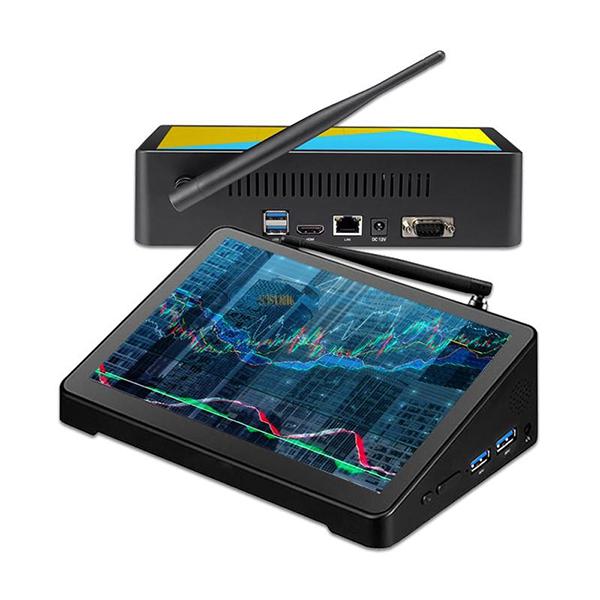Welcome STARK TOUCH DEVICE!
Solutions
Remote firmware update operation for industrial control computers
Industrial Control Computer Remote Firmware Update: Step-by-Step Guide
Industrial control computers (ICCs) require regular firmware updates to maintain performance, security, and compatibility with evolving industrial protocols. Remote updates eliminate the need for on-site interventions, reducing downtime and operational costs. This guide outlines practical methods for executing firmware updates across diverse industrial environments.

Network-Based Update Strategies
Network-based updates leverage existing industrial communication infrastructure, such as Ethernet or wireless networks, to transmit firmware packages. This method is ideal for centralized control systems in manufacturing plants or energy grids.
Ethernet Update Protocols
For devices with Ethernet connectivity, updates can be initiated through TCP/IP protocols. A common approach involves:
Server Configuration: Host firmware files on a secure FTP or HTTP server accessible within the industrial network.
Device Authentication: Configure ICCs to authenticate with the server using credentials or digital certificates.
Triggered Updates: Schedule updates during low-activity periods via scripts or industrial automation platforms.
Example: A factory PLC might download firmware from an internal server at 2 AM, using a cron job to initiate the transfer.
Wireless Update Considerations
Wireless updates (Wi-Fi, 4G/5G) offer flexibility but require robust security measures:
Encryption: Use AES-256 or TLS 1.3 to protect firmware packages during transmission.
Bandwidth Management: Limit update sizes to avoid disrupting real-time control signals.
Fallback Mechanisms: Implement rollback procedures if updates fail mid-transmission.
Practical Tip: Segment wireless networks to isolate ICCs from general IT traffic, reducing interference risks.
Cloud-Integrated Update Systems
Cloud platforms enable centralized management of firmware updates across distributed ICCs. This approach suits multi-site industrial operations, such as water treatment facilities or logistics hubs.
Cloud Update Workflow
Firmware Upload: Upload encrypted firmware packages to a cloud storage service (e.g., AWS S3, Azure Blob).
Device Registration: Register ICCs with unique identifiers in the cloud platform.
Triggered Deployment: Use cloud APIs to push updates to specific devices or groups based on location or function.
Case Study: A global automotive manufacturer uses a cloud-based system to update robotic welding controllers across 15 factories, reducing update cycles from 3 days to 4 hours.
Edge Computing Synergy
Combine cloud updates with edge devices to enhance reliability:
Edge Gateways: Deploy industrial gateways to cache firmware locally, ensuring updates proceed even during cloud outages.
Pre-Validation: Test firmware on edge nodes before full deployment to identify compatibility issues.
Technical Insight: Edge gateways with dual-WAN capabilities can switch between cellular and Ethernet connections to maintain update continuity.
Bootloader-Driven Update Techniques
Bootloader-based updates provide low-level control over firmware replacement, critical for legacy systems or resource-constrained devices.
Serial Bootloader Updates
For ICCs without network capabilities, serial interfaces (RS-232, RS-485) offer a reliable update path:
Enter Bootloader Mode: Trigger bootloader activation via hardware pins or software commands.
Data Transmission: Use tools like Tera Term or PuTTY to send firmware binaries over serial links.
Flash Programming: Write firmware to non-volatile memory (NOR Flash, EEPROM) using bootloader commands.
Example: Updating a motor controller’s firmware via RS-485 requires configuring baud rates (e.g., 115200) and ensuring electrical isolation to prevent noise interference.
USB Bootloader Updates
USB interfaces simplify updates for modern ICCs:
DFU Mode: Leverage Device Firmware Upgrade (DFU) protocols to flash firmware via USB.
Mass Storage Emulation: Treat the ICC as a USB drive, copying firmware files directly to a predefined directory.
Safety Measure: Validate firmware checksums before programming to avoid corrupting critical control logic.
Protocol-Specific Update Considerations
Industrial environments often use proprietary protocols, necessitating tailored update approaches.
Modbus TCP Updates
For PLCs communicating via Modbus TCP:
Register Mapping: Allocate specific registers for firmware version checks and update triggers.
Chunked Transfers: Split firmware into smaller blocks to comply with Modbus’s 125-register payload limit.
Acknowledgment Handling: Implement retry logic for failed transfers due to network congestion.
Optimization: Use Modbus function code 0x6F (Write File Record) for efficient firmware block transfers.
PROFINET Updates
PROFINET devices require adherence to IEC 61158 standards:
GSDML Configuration: Update Generic Station Description Markup Language (GSDML) files to reflect firmware changes.
Cycle Time Adjustment: Temporarily increase PROFINET cycle times during updates to prevent communication timeouts.
Compatibility Check: Verify firmware compatibility with PROFINET Conformance Classes (A, B, C) before deployment.
Security and Validation Best Practices
Remote firmware updates introduce security risks that demand proactive mitigation.
Firmware Signing
Digital Signatures: Sign firmware binaries with private keys stored in hardware security modules (HSMs).
Chain of Trust: Verify signatures at each update stage (cloud → edge → device).
Example: A petrochemical plant uses HSMs to sign PLC firmware, preventing unauthorized modifications.
Rollback Mechanisms
Dual-Bank Flash: Store firmware in separate memory banks to enable automatic rollback on failure.
Golden Image: Maintain a pre-validated “golden” firmware version for emergency recovery.
Testing Protocol: Conduct dry runs in non-production environments to validate rollback procedures.
Validation Testing
Emulation: Test firmware updates in virtualized ICC environments before deployment.
Canary Deployments: Update a small subset of devices first, monitoring for anomalies.
Metric: Track update success rates and failure modes to refine deployment strategies over time.
By integrating these methods, industrial operators can achieve secure, efficient, and scalable firmware updates, ensuring ICCs remain at the forefront of industrial automation.


